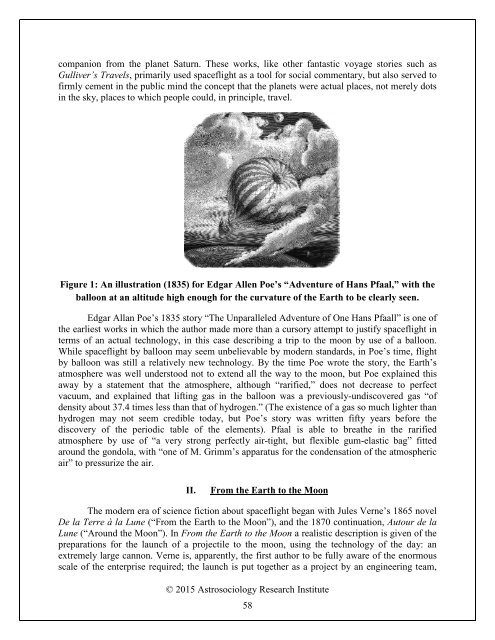THE JOURNAL OF ASTROSOCIOLOGY VOLUME 1
qd9nb3s
qd9nb3s
- No tags were found...
Create successful ePaper yourself
Turn your PDF publications into a flip-book with our unique Google optimized e-Paper software.
companion from the planet Saturn. These works, like other fantastic voyage stories such asGulliver’s Travels, primarily used spaceflight as a tool for social commentary, but also served tofirmly cement in the public mind the concept that the planets were actual places, not merely dotsin the sky, places to which people could, in principle, travel.Figure 1: An illustration (1835) for Edgar Allen Poe’s “Adventure of Hans Pfaal,” with theballoon at an altitude high enough for the curvature of the Earth to be clearly seen.Edgar Allan Poe’s 1835 story “The Unparalleled Adventure of One Hans Pfaall” is one ofthe earliest works in which the author made more than a cursory attempt to justify spaceflight interms of an actual technology, in this case describing a trip to the moon by use of a balloon.While spaceflight by balloon may seem unbelievable by modern standards, in Poe’s time, flightby balloon was still a relatively new technology. By the time Poe wrote the story, the Earth’satmosphere was well understood not to extend all the way to the moon, but Poe explained thisaway by a statement that the atmosphere, although “rarified,” does not decrease to perfectvacuum, and explained that lifting gas in the balloon was a previously-undiscovered gas “ofdensity about 37.4 times less than that of hydrogen.” (The existence of a gas so much lighter thanhydrogen may not seem credible today, but Poe’s story was written fifty years before thediscovery of the periodic table of the elements). Pfaal is able to breathe in the rarifiedatmosphere by use of “a very strong perfectly air-tight, but flexible gum-elastic bag” fittedaround the gondola, with “one of M. Grimm’s apparatus for the condensation of the atmosphericair” to pressurize the air.II.From the Earth to the MoonThe modern era of science fiction about spaceflight began with Jules Verne’s 1865 novelDe la Terre à la Lune (“From the Earth to the Moon”), and the 1870 continuation, Autour de laLune (“Around the Moon”). In From the Earth to the Moon a realistic description is given of thepreparations for the launch of a projectile to the moon, using the technology of the day: anextremely large cannon. Verne is, apparently, the first author to be fully aware of the enormousscale of the enterprise required; the launch is put together as a project by an engineering team,© 2015 Astrosociology Research Institute58


